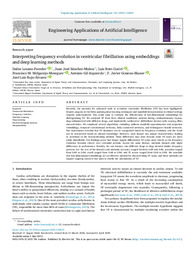Title:
Interpreting frequency evolution in ventricular fibrillation using embeddings and deep learning methods |
Authors:
Lozano-Paredes, Dafne 
SANCHEZ MUÑOZ, JUAN JOSE 
Bote-Curiel, Luis 
Melgarejo Meseguer, Francisco Manuel 
Gil Izquierdo, Antonio 
Gimeno Blanes, Francisco Javier
Rojo-Álvarez, José Luis  |
Editor:
Elsevier |
Department:
Departamentos de la UMH::Ingeniería de Comunicaciones |
Issue Date:
2025 |
URI:
https://hdl.handle.net/11000/37193 |
Abstract:
Recently, the necessity for advanced tools to scrutinize ventricular fibrillation (VF) has been highlighted. Despite progress in the field, applying deep learning techniques and manifold interpretations in clinical settings remains underexplored. This study aims to evaluate the effectiveness of low-dimensional embeddings for distinguishing VF. We analyzed VF from three clinical conditions: patients during cardiopulmonary bypass, dogs administered with different drugs, and implantable cardioverter defibrillator devices with varying offset characteristics. We employed several algorithms, including uniform manifold approximation and projection embeddings, temporal convolutional networks, fully connected networks, and Kolmogorov–Arnold networks. Our experiments revealed that VF dynamics can be categorized based on frequency evolution, and the result can be interpreted based on clinical knowledge. However, each dataset has unique characteristics, leading to variations in the best-performing method. These differences may arise because some VF types are more easily identifiable. Our findings prove that longer signals differentiate VF types more clearly as the frequency evolution becomes clearer over extended periods. Across the same dataset, methods showed only slight differences in performance. Notably, for one dataset, two different drugs in dogs showed similar frequency patterns. For the rest of the datasets and methods, accuracy ranged between 0.68 and 0.86, precision ranged from 0.69 to 0.84, recall ranged from 0.68 to 0.84, and F1 scores ranged from 0.68 to 0.84. We conclude that low-dimensional embeddings are an effective method for characterizing VF types, and these methods can support ongoing research that aims to clarify the mechanisms of VF.
|
Keywords/Subjects:
Ventricular fibrillation
Frequency evolution
Manifold learning
Deep learning
Electrocardiogram analysis Interpretability |
Knowledge area:
CDU: Ciencias aplicadas: Ingeniería. Tecnología |
Type of document:
info:eu-repo/semantics/article |
Access rights:
info:eu-repo/semantics/openAccess
Attribution-NonCommercial-NoDerivatives 4.0 Internacional |
DOI:
https://doi.org/10.1016/j.engappai.2025.110822 |
Published in:
Engineering Applications of Artificial Intelligence |
Appears in Collections:
Artículos Ingeniería Comunicaciones
|

.png)
